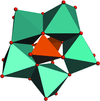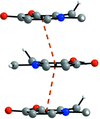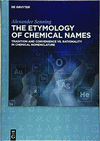issue contents
February 2020 issue

Cover illustration: A single-crystal X-ray structure of a transition-metal complex with a perchlorate anion has been examined at 10, 90, and 170 K for the influence of temperature on Cl-O bond lengths. See Olmstead [Acta Cryst. (2020), C76, 159-163].
scientific commentaries
Free 

A possible solution for improving the water solubility of berberine by the formation of multicomponent pharmaceutical salts provides the background for this commentary.
research papers
Download citation


Download citation


Two CoII- and NiII-based coordination polymers were prepared using 2,5-bis(1H-1,2,4-triazol-1-yl)terephthalic acid and M(OAc)2·4H2O (M = Co and Ni). In the two complex structures, the central CoII and NiII ions adopt distorted octahedral geometries, which are bound by the bifunctional ligands to produce a two-dimensional network. Magnetic studies reveal that the complexes show antiferromagnetic interactions.
Download citation


Download citation


Temperature-induced solid-to-solid transformation resulted in three types of helical chains which turned into one kind of helical chain between two pairs of homochiral coordination polymers.
Download citation


Download citation


A new copper porphyrin with a three-dimensional framework is reported. It has a novel Cu2Cl μ4-bridge and shows a red photoluminescence. Electrochemical experiments revealed that this porphyrin possesses two redox waves (E1/2 = −160 and 91 mV).
CCDC reference: 1943859
Download citation


Download citation


The structures of two newly synthesized tetrachloridoaurates with adenine and guanine counter-cations were studied using single-crystal X-ray diffraction and FT–IR spectroscopic techniques.
Download citation


Download citation


Two new metal–organic frameworks (MOFs) have been hydrothermally synthesized using glutarate mixed with 1,4-bis[(2-methyl-1H-imidazol-1-yl)methyl]benzene. An NiII MOF shows a 4-connected 3D framework with point symbol 66 but is not a typical dia network. A ZnII MOF displays a 2D 44-sql network with 1D water chains penetrating the grids along the c direction. This MOF also exhibits highly selective sensing toward Fe3+ and Cr2O72− ions in aqueous solution.
Download citation


Download citation


A single-crystal X-ray structure of a transition-metal complex with a perchlorate anion has been examined at 10, 90, and 170 K for the influence of temperature on Cl—O bond lengths.
Download citation


Download citation


The crystallographic description of the new polyoxometalate compound (C7H9NO)9[P2Mo5O23]2·3H2O proved to be quite challenging due to the extensive and varied disorder present in the structure. The Hirshfeld surface analysis confirmed that the hydrogen-bonding interactions play a dominating role in the stability of the crystal structure.
CCDC reference: 1843280
Download citation


Download citation


In the crystal structures of crystals of thiourea with 4-nitropyridine N-oxide and 3-bromopyridine N-oxide, both molecular components are linked by N—H⋯S or N—H⋯O hydrogen bonds and C—Br⋯S halogen bonds. The latter interactions were characterized by quantum chemistry (QTAIM) methods and the atoms in molecules (AIM) approach.
Download citation


Download citation


In the heteroleptic cuprous complex [Cu(3-PyNH2)(CH3CN)(BINAP)]PF6·CH2Cl2, 2,2′-bis(diphenylphosphanyl)-1,1′-binaphthyl (BINAP) and 3-aminopyridine (3-PyNH2) exhibit chelating and terminal coordination modes, respectively. Time-dependent density functional theory (TD-DFT) calculations and wavefunction analysis demonstrate that the yellow phosphorescence should emit from a metal-perturbed triplet BINAP-centred excited state.
CCDC reference: 1978344
Download citation


Download citation


Two europium(III) coordination polymers were successfully constructed from 1H-benzimidazole-5,6-dicarboxylic acid and europium(III) ions with different anionic ligands. The anionic ligands not only affect the geometry of the coordination polymers, but can also effectively control their luminescence properties.
Download citation


Download citation


Two novel polymorphic forms of deferiprone were detected during crystallization experiments. In the crystal packing of one polymorph, the deferiprone molecules were aggregated as corrugated sheets, as in the original structure, whereas, in the other novel polymorph, the molecules were aggregated as a square-grid network.
book reviews
Free 

Free 



 journal menu
journal menu































